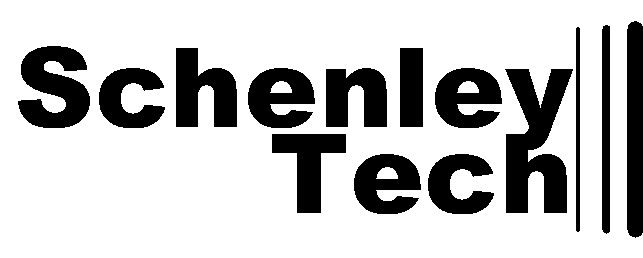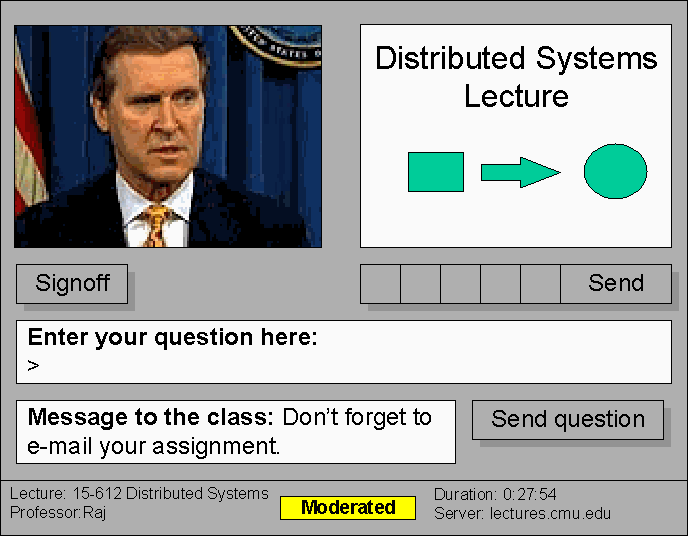 |
Carlos Basto
Hemang Bhojani
Jorge L. Noyola-Picazzo
Carlos E. Olguin
Vicente Zamora
|
15-612 Distributed Systems
Final Project Proposal
Ubiquity - The Anywhere
Classroom
February 2, 1998
Project overview.
The objective of this project is to build
an integrated application that will allow distance learning by using computers
distributed along a computer network, integrating digital video, audio,
data and group collaboration.
By the use of this application, a lecturer
can broadcast a lecture throughout the network to different attendants
located in remote locations. This attendants will receive in their computers,
with a different application, digital video and audio from the lecturerís
workstation, as well as a "whiteboard" with whatever data the lecturer
wishes to display. They will be able to interact with him by typing their
questions in their computers, and sending them to the teacher.
Also, in order to provide better control
when large audiences are involved, there will be a moderator which will
act as an assistant to the lecturer, by receiving first the questions from
the attendants, moderating (filtering or summarizing) them, and relaying
them to the lecturer, so he can answer to them within his lecture. Also,
this assistant can communicate via two-way video with the lecturer in order
to assist him, and correct the whiteboard the teacher is displaying.
The whiteboard can be modified by the teacher
as he displays it in order to point specifics of it or to make last minute
corrections, and can also allow the moderator to make this corrections.
Once any correction is completed, the new whiteboard is broadcasted again
to the attendant workstations. On their workstations, the student can also
make annotations to the whiteboard and submit these to the moderator or
to the professor.
The attendants will sign on into a lecture
by selecting it from a directory service which will provide the security
required for the application, such as allowing lecturers to start broadcasting
a lecture, verifying the identities of lecturers, moderators and attendants,
and keep the security-administrative database.
Application design.
Mainly, the application will consist of
four main modules with different functionalities, depending on the role
of the user. These modules will be the Teacher module, the Moderator
module (which actually is the teacher module, but with limited capabilities),
the Student module and the Directory module, each usually
running on separate computers. A detailed explanation of the functions
that each application will have is shown below:
| Module |
Functions |
| Teacher |
-
Broadcast real-time, live video to each workstation
attending the lecture
-
Receive video transmitted from the moderatorís
workstation
-
Read slides from files into the whiteboard,
and broadcast them to the students
-
Modify the contents of the whiteboard
-
Receive questions forwarded from the moderator
or from the students if thereís no moderator present
-
Allow the moderator to modify the slide thatís
currently being displayed
-
Relay selected questions to students workstations
-
Sign-on in a lecture
|
| Moderator |
-
Receive questions and comments via text from
the students and relay selected or new ones to the teacher
-
Send real-time, live video to the teacherís
workstation
-
Receive broadcasted video from teacherís workstation
-
Modify whiteboards provided by the teacher
-
Broadcast text messages to studentsí workstations
-
Sign-on in a lecture
-
Keep a log of asked and relayed questions
|
| Student |
-
Receive broadcasted video from the teacherís
workstation
-
Receive broadcasted whiteboard from teacherís
workstation
-
Receive broadcasted messages from moderatorís
workstation
-
Send questions to teacher/moderator workstations
-
Sign-on in a lecture
|
| Directory |
-
Manage security
-
Allow teachers to sign-on to start a lecture
-
Show available lectures
-
Create lecture "tickets" and issue them to
students and moderators
|
The module interaction would be structured
as follows:
 Application flow
Application flow
The sequence followed by the workstations
to bring up all the modules of the application would be as follows:
-
The Directory would always be up and
running, since it is in charge of the security of the whole application
and acts as a server for the rest of the modules.
-
For a lecture to begin, the Teacher must
sign-on in the Directory, thus activating his lecture and making
it available for the rest of the applications. When the teacher signs-on,
a ticket is issued to the module, which keeps it for the rest of the lecture.
This ticket will be used to authenticate other users that try to sign-on
to the lecture.
-
The moderator plays an optional role in the
application. It will also sign-on with the Directory, that will
check its identity and issue a ticket that will identify him as a moderator,
and returning to the application the address of the Teacher, where
it will connect automatically, authenticating itself with the ticket it
will receive from the Directory.
-
The role of the Moderator is optional.
If the Moderator is not present, the Teacher will receive
all the data that is supposed to be sent to the Moderator. A Moderator
can also sign-on late, in which case the Teacher will broadcast
the new location of the moderator to all the Student workstations.
-
The Student workstations sign-on to
the directory and get a listing of all the active lectures theyíre allowed
to attend. Once they pick one, the Directory will issue the ticket
for the lecture and give the address where it should connect, this connection
will be performed automatically by the application.
-
Every workstation that tries to attend the
lecture, either Student or Moderator, will be accepted by
the Teacher only if the ticket they carry is the same as the one
given to it when the lecture was started. This authentication will be transparent,
no user intervention will be required.
-
The Teacher workstation will be continuously
broadcasting video, audio and graphics to every workstation connected to
it.
-
When a Student wishes to ask a question,
he will type it in his application and submit it. This question will be
automatically sent to the Moderator, or to the Teacher, if
no Moderator is present.
-
The Moderator will select or summarize
the questions, and relay them to the Teacher. When theyíre sent
to the Teacher, it will also be broadcasted to the Students,
so theyíre aware of what was exactly the question asked to the Teacher.
-
The Teacher will be able to modify
the whiteboard thatís being broadcasted to the Students. When he
does that, the modified whiteboard will be transmitted to the other workstations.
-
Since the Teacher will have two-way
communication with the Moderator, the Teacher will also be
able to share the whiteboard with him, allowing modifications to the whiteboard,
that will be broadcasted back to the Students.
-
When the Teacher decides to finish
the lecture, it will notify all the workstations before signing off.
Implementation specifications
The platform that will be used to implement
the application will be Java, in order to allow portability across different
platforms, and because of the facilities provided to handle TCP/IP networking.
The different modules will reside as independent
classes or applets in a web server, and will be launched from a web browser
such as Netscape of Microsoft Internet Explorer. This applets will only
be accessible after a secure login and wonít allow access to them without
a proper authentication.
The audio and video will be transmitted
over the network as a real-time stream, and the libraries required to handle
it will also be developed in Java.
Interface design
The application will have a Java based
GUI, and each of the modules will have itís own independent interface that
will be displayed (except for the Directory) in a Java console on
the screen.
The interface for each of the modules will
be the following:

All the modules would have a similar interface,
varying only in some of the capabilities they can have, and the audio/video
source. For example, the Teacher interface would have also a button
to share the whiteboard with the moderator, and the Moderator would
have a control to forward the messages and graphics received to the Teacher.



